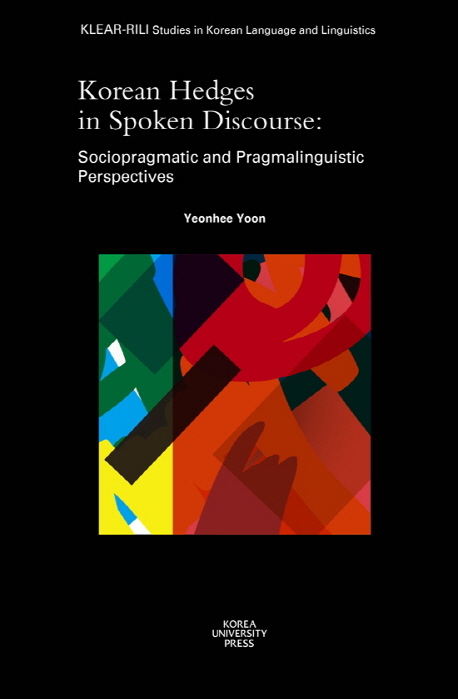Korean Hedges in Spoken Discourse(양장본 HardCover)
Sociopragmatic and Pragmalinguistic Perspectives
AUTHOR :
Youn Yeonhee
ISBN : 9788976418999
PUBLISHER : 고려대학교출판문화원
PUBLICATION DATE :
May 01 ,2016,
SPINE SIZE : 0 inches
PAGES : 220
SIZE : 6.3 * 9.1 inches
WEIGHT : 1.2 pounds
CATON QTY : 22
PRICE : $42.95
As summarized in the preface of the book, Dr. Yoon’s research, the first of its kind in Korean linguistics, makes several important descriptive and theoretical contributions to general socio-pragmatic studies. For instance, Dr. Yoon discovered that Korean hedges, functioning as interactive strategies, are used more frequently in two-party than many-party conversations and more frequently in personal than impersonal topics. Her study also reveals that hedges are used as both positive and negative politeness strategies and that social situational factors are more influential in affecting hedge use than social structural factors such as gender, age, region, or occupation.
Youn Yeonhee
Yeonhee Yoon is Associate Professor of the Practice of Korean Language and Culture at the Department of East Asian Languages and Cultures and faculty fellow at the Liu Institute of Asia and Asian Studies at the University of Notre Dame. She received her Ph.D. in Korean Linguistics from the University of Hawai’i at Manoa. Her research interests include Intercultural Pragmatics, Second Language Acquisition, and Korean popular culture. Her current project focuses on Korean History and Culture through Film, Korean Popular Culture and migration, Korean Language and Culture for International Negotiations and Diplomacy, and Korean language for academic purpose.
CHAPTER 1 INTRODUCTION
1.1 Objectives
1.2 Research questions
1.3 Organization of the dissertation
CHAPTER 2 LITERATURE REVIEW
2.1 The concept of hedge
2.2 Women’s use of hedges and powerless language
2.3 Linguistic politeness and hedges
2.4 Mitigation and hedges
2.5 The functions of hedges
2.6 Modality and hedges
2.7 Speech acts and hedges
2.8 Hedges as a negative politeness vs. hedges as a positive politeness
2.9 Korean sentence enders and discourse modality
CHAPTER 3 METHODOLOGY AND DATA
3.1 Data collection and methodology
3.2 Yoon’s data overview
3.3 Summary
CHAPTER 4 THE CLASSIFICATION AND FREQUENCY OF KOREAN
HEDGES IN SPOKEN DISCOURSE
4.1 Classification of Korean hedges in spoken discourse
4.2 Frequency of Korean hedges in spoken discourse
4.3 Summary
CHAPTER 5 SOCIOPRAGMATIC ANALYSIS OF INTERACTIVE SENTENCE ENDERS
5.1 Sociopragmatic factor analysis
5.2 Summary of sociopragmatic analysis of seven ISEs
5.3 Re-examination of two major findings
5.4 Summary
CHAPTER 6 PRAGMALINGUISTIC ANALYSIS OF SELECTED HEDGES
6.1 Pragmalinguistic analysis of ISE -canha(yo)
6.2 Pragmalinguistic analysis of ISE -ketun(yo)
6.3 Summary
CHAPTER 7 CONCLUSION
7.1 General remarks
7.2 Summary of findings
7.3 Pedagogical implications
7.4 Suggestions for future studies
BIBLIOGRAPHY
1.1 Objectives
1.2 Research questions
1.3 Organization of the dissertation
CHAPTER 2 LITERATURE REVIEW
2.1 The concept of hedge
2.2 Women’s use of hedges and powerless language
2.3 Linguistic politeness and hedges
2.4 Mitigation and hedges
2.5 The functions of hedges
2.6 Modality and hedges
2.7 Speech acts and hedges
2.8 Hedges as a negative politeness vs. hedges as a positive politeness
2.9 Korean sentence enders and discourse modality
CHAPTER 3 METHODOLOGY AND DATA
3.1 Data collection and methodology
3.2 Yoon’s data overview
3.3 Summary
CHAPTER 4 THE CLASSIFICATION AND FREQUENCY OF KOREAN
HEDGES IN SPOKEN DISCOURSE
4.1 Classification of Korean hedges in spoken discourse
4.2 Frequency of Korean hedges in spoken discourse
4.3 Summary
CHAPTER 5 SOCIOPRAGMATIC ANALYSIS OF INTERACTIVE SENTENCE ENDERS
5.1 Sociopragmatic factor analysis
5.2 Summary of sociopragmatic analysis of seven ISEs
5.3 Re-examination of two major findings
5.4 Summary
CHAPTER 6 PRAGMALINGUISTIC ANALYSIS OF SELECTED HEDGES
6.1 Pragmalinguistic analysis of ISE -canha(yo)
6.2 Pragmalinguistic analysis of ISE -ketun(yo)
6.3 Summary
CHAPTER 7 CONCLUSION
7.1 General remarks
7.2 Summary of findings
7.3 Pedagogical implications
7.4 Suggestions for future studies
BIBLIOGRAPHY
